Land Use Carbon Emissions or Sink: Research Characteristics, Hotspots and Future Perspectives
Abstract
:1. Introduction
2. Materials and Methods
3. Results
3.1. Research Characteristics
3.1.1. Global Trends of Articles
3.1.2. National Distribution Characteristics
3.1.3. Institutional Distribution Characteristics
3.1.4. Distribution Characteristics of Journals
3.1.5. Characteristics of Subject Categories
3.2. Research Hotspot Analysis
3.2.1. Analysis of Top 10 Highly Cited Papers
3.2.2. Keyword Cluster Analysis
3.2.3. Analysis of Theme Evolution
3.2.4. Research Frontier Analysis
4. Literature Review and Discussion
4.1. Research Progress
4.2. Future Perspectives
5. Conclusions
Author Contributions
Funding
Data Availability Statement
Acknowledgments
Conflicts of Interest
References
- IEA (International Energy Agency). The Breakthrough Agenda Report 2022. 2022. Available online: https://iea.blob.core.windows.net/assets/49ae4839-90a9-4d88-92bc-371e2b24546a/THEBREAKTHROUGHAGENDAREPORT2022.pdf (accessed on 1 October 2023).
- Friedlingstein, P.; O’Sullivan, M.; Jones, M.W.; Andrew, R.M.; Bakker, D.C.E.; Hauck, J.; Landschützer, P.; Quéré, C.L.; Luijkx, I.T.; Peters, G.P.; et al. Global carbon budget 2023. Earth Syst. Sci. Data 2023, 15, 5301–5369. [Google Scholar] [CrossRef]
- U.S. Department of Agriculture’s Forest Service. USDA Forest Service Report Highlights Threats to Forest, Rangeland Health over the Next 50 Years. 2023. Available online: https://www.fs.usda.gov/sites/default/files/fs_media/fs_document/2020-RPA-Assessment.pdf (accessed on 2 December 2023).
- EEA (European Environment Agency). Trends and Projections in Europe 2022. 2022. Available online: https://www.eea.europa.eu/publications/trends-and-projections-in-europe-2022 (accessed on 1 October 2023).
- Yu, Z.; Ciais, P.; Piao, S.L.; Hougthon, R.A.; Lu, C.Q.; Tian, H.Q.; Agathokleous, E.; Kattel, R.R.; Sitch, S.; Goll, D.; et al. Forest expansion dominates China’s land carbon sink since 1980. Nat. Commun. 2022, 458, 1009–1013. [Google Scholar] [CrossRef] [PubMed]
- Futurearth; The Earth League; World Climate Research Programme. 10 New Insights in Climate Science 2022. 2022. Available online: https://10insightsclimate.science/wp-content/uploads/2022/11/10NICS-2022-Report_digital.pdf (accessed on 1 October 2023).
- IEA (International Energy Agency). Credible Pathways to 1.5 °C: Four Pillars for Action in the 2020s. 2023. Available online: https://iea.blob.core.windows.net/assets/ea6587a0-ea87-4a85-8385-6fa668447f02/Crediblepathwaysto1.5C-Fourpillarsforactioninthe2020s.pdf (accessed on 2 December 2023).
- Chen, W.X.; Gu, T.C.; Fang, C.L.; Zeng, J. Global urban low-carbon transitions: Multiscale relationship between urban land and carbon emissions. Environ. Impact Assess. Rev. 2023, 100, 107076. [Google Scholar] [CrossRef]
- Zhou, Y.; Chen, M.X.; Tang, Z.P.; Mei, Z. Urbanization, land use change, and carbon emissions: Quantitative assessments for city-level carbon emissions in Beijing-Tianjin-Hebei region. Sustain. Cities Soc. 2021, 66, 102701. [Google Scholar] [CrossRef]
- Lin, Q.W.; Zhang, L.; Qiu, B.K.; Zhao, Y.; Wei, C. Spatiotemporal analysis of land use patterns on carbon emissions in China. Land 2021, 10, 141. [Google Scholar] [CrossRef]
- Hill, J.; Nelson, E.; Tilman, D.; Tiffany, D. Environmental, economic, and energetic costs and benefits of biodiesel and ethanol biofuels. Proc. Natl. Acad. Sci. USA 2006, 103, 11206–11210. [Google Scholar] [CrossRef]
- Fargion, J.; Hill, J.; Tilman, D.; Polasky, S.; Hawthorne, P. Land clearing and the biofuel carbon debt. Science 2008, 319, 1235–1238. [Google Scholar] [CrossRef]
- Van Der Werf, G.R.; Randerson, J.T.; Giglio, L.; Van Leeuwen, T.T.; Chen, Y.; Rogers, B.M.; Mu, M.; Van Marle, M.J.E.; Morton, D.C.; Collatz, G.J.; et al. Global fire emissions estimates during 1997–2016. Earth Syst. Sci. Data 2017, 9, 697–720. [Google Scholar] [CrossRef]
- Quéré, C.L.; Andrew, R.M.; Canadell, J.G.; Sitch, S.; Korsbakken, J.I.; Peters, G.P.; Manning, A.C.; Boden, T.A.; Tans, P.P.; Houghton, R.A.; et al. Global carbon budget 2016. Earth Syst. Sci. Data 2016, 8, 605–649. [Google Scholar] [CrossRef]
- Liu, Z.; Guan, D.B.; Wei, W.; Davis, S.J.; Ciais, P.; Bai, J.; Peng, S.S.; Zhang, Q.; Hubacek, K.; Marland, G.; et al. Reduced carbon emission estimates from fossil fuel combustion and cement production in China. Nature 2015, 524, 335–338. [Google Scholar] [CrossRef]
- Morán, M.A.T.; González, P.R. Structural factors affecting land-transport CO2 emissions: A European comparison. Transport. Res. Part D-Transport. Environ. 2007, 12, 239–253. [Google Scholar] [CrossRef]
- Yang, H.C.; Ma, J.T.; Jiao, X.Y.; Shang, G.F.; Yan, H.M. Characteristics and driving mechanism of urban construction land expansion along with rapid urbanization and carbon neutrality in Beijing, China. Land 2023, 12, 1388. [Google Scholar] [CrossRef]
- Zhang, C.B.; Hu, M.M.; Dong, L.; Xiang, P.C.; Zhang, Q.; Wu, J.B.; Li, B.; Shi, S.Y. Co-benefits of urban concrete recycling on the mitigation of greenhouse gas emissions and land use change: A case in Chongqing metropolis, China. J. Clean. Prod. 2018, 201, 481–498. [Google Scholar] [CrossRef]
- Aryapratama, R.; Pauliuk, S. Life cycle carbon emissions of different land conversion and woody biomass utilization scenarios in Indonesia. Sci. Total Environ. 2022, 805, 150226. [Google Scholar] [CrossRef]
- Wu, H.J.; Hanna, M.A.; Jones, D.D. Life cycle assessment of greenhouse gas emissions of feedlot manure management practices: Land application versus gasification. Biomass Bioenergy 2013, 54, 260–266. [Google Scholar] [CrossRef]
- Levasseur, A.; Lesage, P.; Margni, M.; Brandão, M.; Samson, R. Assessing temporary carbon sequestration and storage projects through land use, land-use change and forestry: Comparison of dynamic life cycle assessment with ton-year approaches. Clim. Chang. 2012, 115, 759–776. [Google Scholar] [CrossRef]
- Pacala, S.W.; Hurtt, G.C.; Baker, D.; Peylin, P.; Houghton, R.A.; Birdsey, R.A.; Heath, L.; Sundquist, E.T.; Stallard, R.F.; Ciais, P.; et al. Consistent land- and atmosphere-based U.S. carbon sink estimates. Science 2001, 292, 2316–2320. [Google Scholar] [CrossRef] [PubMed]
- Piao, S.L.; Huang, M.T.; Liu, Z.; Wang, X.H.; Ciais, P.; Canadell, J.G.; Wang, K.; Bastos, A.; Friedlingstein, P.; Houghton, R.A.; et al. Lower land-use emissions responsible for increased net land carbon sink during the slow warming period. Nat. Geosci. 2018, 11, 739–743. [Google Scholar] [CrossRef]
- Potter, C.; Klooster, S.; Hiatt, S.; Fladeland, M.; Genovese, V.; Gross, R. Satellite-derived estimates of potential carbon sequestration through afforestation of agricultural lands in the United States. Clim. Chang. 2007, 80, 323–336. [Google Scholar] [CrossRef]
- Hoekman, S.K.; Broch, A. Environmental implications of higher ethanol production and use in the U.S.: A literature review. Part II—Biodiversity, land use change, GHG emissions, and sustainability. Renew. Sustain. Energy Rev. 2018, 81, 3159–3177. [Google Scholar] [CrossRef]
- Bristow, M.; Hutley, L.B.; Beringer, J.; Livesley, S.J.; Edwards, A.C.; Arndt, S.K. Quantifying the relative importance of greenhouse gas emissions from current and future savanna land use change across northern Australia. Biogeosciences 2016, 13, 6285–6303. [Google Scholar] [CrossRef]
- Berger, S.; Bliefernicht, J.; Linstädter, A.; Canak, K.; Guug, S.; Heinzeller, D.; Hingerl, L.; Mauder, M.; Neidl, F.; Quansah, E.; et al. The impact of rain events on CO2 emissions from contrasting land use systems in semi-arid West African savannas. Sci. Total Environ. 2019, 647, 1478–1489. [Google Scholar] [CrossRef] [PubMed]
- Zhong, J.T.; Zhang, X.Y.; Guo, L.F.; Wang, D.Y.; Miao, C.H.; Zhang, X.L. Ongoing CO2 monitoring verify CO2 emissions and sinks in China during 2018–2021. Sci. Bull. 2023, 68, 2467–2476. [Google Scholar] [CrossRef] [PubMed]
- Marvin, D.C.; Sleeter, B.M.; Cameron, R.; Nelson, E.; Plantinga, A.J. Natural climate solutions provide robust carbon mitigation capacity under future climate change scenarios. Sci. Rep. 2023, 13, 19008. [Google Scholar] [CrossRef] [PubMed]
- Gatti, L.V.; Cunha, C.L.; Marani, L.; Cassol, H.L.G.; Messias, C.G.; Arai, E.; Denning, S.; Soler, L.S.; Almeida, C.; Setzer, A.; et al. Increased Amazon carbon emissions mainly from decline in law enforcement. Nature 2023, 621, 318–323. [Google Scholar] [CrossRef] [PubMed]
- Winkler, K.; Yang, H.; Ganzenmüller, R.; Fuchs, R.; Ceccherini, G.; Duveiller, G.; Grassi, G.; Pongratz, J.; Bastos, A.; Dhvidenko, A.; et al. Changes in land use and management led to a decline in Eastern Europe’s terrestrial carbon sink. Commun. Earth Environ. 2023, 4, 237. [Google Scholar] [CrossRef]
- Guedes, G.B.; Paganin, L.B.Z.; Borsato, M. Bibliometric and systemic analysis on material flow mapping and industrial ecosystems. J. Ind. Integr. Manag. 2018, 3, 1850001. [Google Scholar] [CrossRef]
- Liu, L.N.; Qu, J.S.; Maraseni, T.N.; Niu, Y.B.; Zeng, J.J.; Zhang, L.H.; Xu, L. Household CO2 emissions: Current status and future perspectives. Int. J. Environ. Res. Public Health 2020, 17, 7077. [Google Scholar] [CrossRef]
- Xu, Y.; Yang, Y.P.; Chen, X.N.; Liu, Y.X.Y. Bibliometric analysis of global NDVI research trends from 1985 to 2021. Remote. Sens. 2022, 14, 3967. [Google Scholar] [CrossRef]
- Chen, C.M. CiteSpace II: Detecting and visualizing emerging trends and transient patterns in scientific literature. J. Am. Soc. Inf. Sci. Technol. 2005, 57, 359–377. [Google Scholar] [CrossRef]
- Souza, L.; Bueno, C. City information modelling as a support decision tool for planning and management of cities: A systematic literature review and bibliometric analysis. Build. Environ. 2022, 207, 108403. [Google Scholar] [CrossRef]
- Huang, J.P.; Yu, H.P.; Guan, X.D.; Wang, G.Y.; Guo, R.X. Accelerated dryland expansion under climate change. Nat. Clim. Chang. 2016, 6, 166–171. [Google Scholar] [CrossRef]
- Riahi, K.; Vuuren, D.P.; Kriegler, E.; Edmonds, J.; Neill, B.C.O.; Fujimori, S.; Bauer, N.; Calvin, K.; Dellink, R.; Fricko, O.; et al. The shared socioeconomic pathways and their energy, land use, and greenhouse gas emissions implications: An overview. Glob. Environ. Change Hum. Policy Dimens. 2017, 42, 153–168. [Google Scholar] [CrossRef]
- Griscom, B.; Adams, J.; Ellis, P.W.; Houghton, R.A.; Lomax, G.; Miteva, D.A.; Schlesinger, W.H.; Shoch, D.; Siikamäki, J.V.; Smith, P.; et al. Natural climate solutions. Proc. Natl. Acad. Sci. USA 2017, 114, 11645–11650. [Google Scholar] [CrossRef] [PubMed]
- Poulter, B.; Frank, D.; Ciais, P.; Myneni, R.B.; Andela, N.; Bi, J.; Broquet, G.; Canadell, J.G.; Chevallier, F.; Liu, Y.Y.; et al. Contribution of semi-arid ecosystems to interannual variability of the global carbon cycle. Nature 2014, 509, 600–603. [Google Scholar] [CrossRef] [PubMed]
- Ahlström, A.; Raupach, M.R.; Schurgers, G.; Smith, B.; Arneth, A.; Jung, M.; Reichstein, M.; Canadell, J.G.; Friedlingstein, P.; Jain, A.K.; et al. The dominant role of semi-arid ecosystems in the trend and variability of the land CO2 sink. Science 2015, 348, 895–899. [Google Scholar] [CrossRef] [PubMed]
- Friedlingstein, P.; Jones, M.W.; O’Sullivan, M.; Andrew, R.M.; Hauck, J.; Peters, G.P.; Peters, W.; Pongrazt, J.; Sitch, S.; Quéré, C.L.; et al. Global carbon budget 2019. Earth Syst. Sci. Data 2019, 11, 1783–1838. [Google Scholar] [CrossRef]
- Giorgetta, M.A.; Jungclaus, J.; Reick, C.H.; Legutke, S.; Bader, J.; Böttinger, M.; Brovkin, V.; Crueger, T.; Esch, M.; Fieg, K.; et al. Climate and carbon cycle changes from 1850 to 2100 in MPI-ESM simulations for the Coupled Model Intercomparison Project phase 5. J. Adv. Model. Earth. Syst. 2013, 3, 572–597. [Google Scholar] [CrossRef]
- Liu, L.N.; Zeng, J.J.; Wu, X.N.; Qu, J.S.; Li, X.M.; Zhang, J.; Han, J.Y. Review on eco-environment research in the Yellow River Basin: A bibliometric perspective. Int. J. Environ. Res. Public Health 2022, 19, 11986. [Google Scholar] [CrossRef]
- Swisher, J.N. Cost and performance of CO2 storage in forestry projects. Biomass Bioenergy 1991, 1, 317–328. [Google Scholar] [CrossRef]
- Le Quéré, C.; Raupach, M.R.; Canadell, J.G.; Marland, G.; Bopp, L.; Ciais, P.; Conway, T.J.; Doney, S.C.; Feely, R.A.; Foster, P.; et al. Trends in the sources and sinks of carbon dioxide. Nat. Geosci. 2009, 2, 831–836. [Google Scholar] [CrossRef]
- Piao, S.L.; Fang, J.Y.; Ciais, P.; Peylin, P.; Huang, Y.; Sitch, S.; Wang, T. The carbon balance of terrestrial ecosystems in China. Nature 2009, 458, 1009–1013. [Google Scholar] [CrossRef]
- Gonzalez-Salazar, M.A.; Venturini, M.; Poganietz, W.R.; Finkenrath, M.; Kirsten, T.; Acevedo, H.; Spina, P.G. A general modeling framework to evaluate energy, economy, land-use and GHG emissions nexus for bioenergy exploitation. Appl. Energy 2016, 178, 223–249. [Google Scholar] [CrossRef]
- Pereira, N.; Bonduki, Y.; Perdomo, M. Potential options to reduce GHG emissions in Venezuela. Appl. Energy 1997, 56, 265–286. [Google Scholar] [CrossRef]
- Searchinger, T.; Heimlich, R.; Honghton, R.A.; Dong, F.X.; Elobeid, A.; Fabiosa, J.; Tokgoz, S.; Hayes, D.; Yu, T.H. Use of U.S. Croplands for biofuels increases greenhouse gases through emissions from land-use change. Science 2009, 319, 1238–1240. [Google Scholar] [CrossRef]
- Pan, Y.; Birdsey, R.A.; Fang, J.Y.; Houghton, R.; Kauppi, P.E.; Kurz, W.A.; Phillips, O.L.; Shvidenko, A.; Lewis, S.; Canadell, J.G.; et al. A large and persistent carbon sink in the world’s forests. Science 2011, 333, 988–993. [Google Scholar] [CrossRef] [PubMed]
- Bhan, M.; Gingrich, S.; Roux, N.; Noë, J.L.; Kastner, T.; Matej, S.; Schwarzmueller, E.; Erb, K.H. Quantifying and attributing land use-induced carbon emissions to biomass consumption: A critical assessment of existing approaches. J. Environ. Manag. 2021, 286, 112228. [Google Scholar] [CrossRef] [PubMed]
- Wu, H.; Fang, S.M.; Zhang, C.; Hu, S.W.; Nang, D.; Yang, Y.Y. Exploring the impact of urban form on urban land use efficiency under low-carbon emission constraints: A case study in China’s Yellow River Basin. J. Environ. Manag. 2006, 311, 114866. [Google Scholar] [CrossRef] [PubMed]
- Marques, A.; Martins, I.S.; Kastner, T.; Plutzar, C.; Theurl, M.C.; Eisenmenger, N.; Huijbregts, M.A.J.; Wood, R.; Stadler, K.; Bruckner, M.; et al. Increasing impacts of land use on biodiversity and carbon sequestration driven by population and economic growth. Nat. Ecol. Evol. 2019, 3, 628–637. [Google Scholar] [CrossRef] [PubMed]
- Liu, W.G.; Yan, Y.; Wang, D.X.; Ma, W. Integrate carbon dynamics models for assessing the impact of land use intervention on carbon sequestration ecosystem service. Ecol. Indic. 2018, 91, 268–277. [Google Scholar] [CrossRef]
- Fischer-Kowalski, M. Society’s metabolism: The intellectual history of material flow analysis, Part I, 1860–1970. J. Ind. Ecol. 1998, 2, 61–78. [Google Scholar] [CrossRef]
- Saeki, T.; Patra, P.K. Implications of overestimated anthropogenic CO2 emissions on East Asian and global land CO2 flux inversion. Geosci. Lett. 2017, 4, 9. [Google Scholar] [CrossRef]
- Newell, J.P.; Vos, R.O. Accounting for forest carbon pool dynamics in product carbon footprints: Challenges and opportunities. Environ. Impact Assess. Rev. 2012, 37, 23–36. [Google Scholar] [CrossRef]
- Zhang, G.L.; Zhang, N.; Liao, W.M. How do population and land urbanization affect CO2 emissions under gravity center change? A spatial econometric analysis. J. Clean. Prod. 2018, 202, 510–523. [Google Scholar] [CrossRef]
- Wei, B.; Kasimu, A.; Reheman, R.; Zhang, X.L.; Zhao, Y.Y.; Aizizi, Y.; Liang, H.W. Spatiotemporal characteristics and prediction of carbon emissions/absorption from land use change in the urban agglomeration on the northern slope of the Tianshan Mountains. Ecol. Indic. 2023, 151, 110329. [Google Scholar] [CrossRef]
- Ehrlich, P.R.; Holdren, J.P. The impact of population growth. Science 1971, 171, 1212–1217. [Google Scholar] [CrossRef] [PubMed]
- Mahony, T.O. Decomposition of Ireland’s carbon emissions from 1990 to 2010: An extended kaya identity. Energy Policy 2013, 59, 573–581. [Google Scholar] [CrossRef]
- Liu, L.N.; Qu, J.S.; Clarke-Sather, A.; Maraseni, T.; Pang, J. Spatial variations and determinants of per capita household CO2 emissions (PHCEs) in China. Sustainability 2017, 9, 1277. [Google Scholar] [CrossRef]
- Liu, L.N.; Qu, J.S.; Zhang, Z.Q.; Zeng, J.; Wang, J.; Dong, L.; Pei, H.; Liao, Q. Assessment and determinants of per capita household CO2 emissions (PHCEs) based on capital city level in China. J. Geogr. Sci. 2018, 28, 1467–1484. [Google Scholar] [CrossRef]
- Qu, J.S.; Liu, L.N.; Zeng, J.J.; Zhang, Z.; Wang, J.; Pei, H.; Dong, L.; Liao, Q.; Maraseni, T. The impact of income on household CO2 emissions in China based on a large sample survey. Sci. Bull. 2019, 64, 351–353. [Google Scholar] [CrossRef]
- Liu, C.H.; Li, K.Q. Mapping the field: A bibliometric analysis of land use and carbon emissions (LUCE) research from 1987 to 2018. Libr. Hi Tech 2023, 12, 1220. [Google Scholar] [CrossRef]
- Wang, M.; Wang, Y.; Wu, Y.M.; Yue, X.L.; Wang, M.J.; Hu, P.P. Identifying the spatial heterogeneity in the effects of the construction land scale on carbon emissions: Case study of the Yangtze River Economic Belt, China. Environ. Res. 2022, 212, 113397. [Google Scholar] [CrossRef]
- Kang, T.T.; Wang, H.; He, Z.Y.; Liu, Z.Y.; Ren, Y.; Zhao, P.J. The effects of urban land use on energy-related CO2 emissions in China. Sci. Total Environ. 2023, 870, 161873. [Google Scholar] [CrossRef] [PubMed]
- Zhang, M.M.; Zhang, Z.Y.; Tong, B.; Ren, B.; Zhang, L.; Lin, X.H. Analysis of the coupling characteristics of land transfer and carbon emissions and its influencing factors: A case study of China. Front. Environ. Sci. 2023, 10, 1105552. [Google Scholar] [CrossRef]
- Qu, J.S.; Liu, L.N.; Zeng, J.J.; Maraseni, T.N.; Zhang, Z.Q. City-level determinants of household CO2 emissions per person: An empirical study based on a large survey in China. Land 2022, 11, 925. [Google Scholar] [CrossRef]
- Chakir, R.; De Cara, S.; Bruno, V. Price-induced changes in greenhouse gas emissions from agriculture, forestry, and other land use: A spatial panel econometric analysis. Rev. Économique 2017, 68, 471–490. [Google Scholar] [CrossRef]
- Lu, X.L.; Kicklighter, D.W.; Melillo, J.M.; Reilly, J.M.; Xu, L.Y. Land carbon sequestration within the conterminous United States: Regional- and state-level analyses. Biogeosciences 2015, 120, 379–398. [Google Scholar] [CrossRef]
- Guo, Y.X.; Boughton, E.; Qiu, J.X. Interactive effects of land-use intensity, grazing and fire on decomposition of subtropical seasonal wetlands. Ecol. Indic. 2021, 132, 108301. [Google Scholar] [CrossRef]
- Shirkey, G.; John, R.; Chen, J.Q.; Kolluru, V.; Amirkhiz, R.G.; Marquart-Pyatt, S.T.; Cooper, L.T.; Collins, M. Land cover change and socioecological influences on terrestrial carbon production in an agroecosystem. Landsc. Ecol. 2023, 38, 3845–3867. [Google Scholar] [CrossRef]
- Turner, D.P.; Ritts, W.D.; Yang, Z.Q.; Kennedy, R.E.; Cohen, W.B.; Duane, M.V.; Thornton, P.E.; Law, B.E. Decadal trends in net ecosystem production and net ecosystem carbon balance for a regional socioecological system. For. Ecol. Manag. 2011, 262, 1318–1325. [Google Scholar] [CrossRef]
- Ye, X.; Chuai, X.W. Carbon sinks/sources’ spatiotemporal evolution in China and its response to built-up land expansion. J. Environ. Manag. 2022, 321, 115863. [Google Scholar] [CrossRef]
- Wang, Y.Y.; Ding, Z.Y.; Ma, Y.M. Data processing uncertainties may lead to an overestimation of the land carbon sink of the Tibetan Plateau. Proc. Natl. Acad. Sci. USA 2022, 119, e2202343119. [Google Scholar] [CrossRef]
- Futurearth; The Earth League; World Climate Research Programme. 10 New Insights in Climate Science 2023/2024. 2023. Available online: https://10insightsclimate.science/ (accessed on 2 December 2023).
- Krcmar, E.; Stennes, B.; Kooten, G.C.V.; Vertinsky, I. Carbon sequestration and land management under uncertainty. Eur. J. Oper. Res. 2001, 135, 616–629. [Google Scholar] [CrossRef]
- Schimel, D.S.; House, J.I.; Hibbard, K.A.; Bousquet, P.; Ciais, P.; Peylin, P.; Braswell, B.H.; Apps, M.J.; Baker, D.; Bondeau, A.; et al. Recent patterns and mechanisms of carbon exchange by terrestrial ecosystems. Nature 2001, 414, 169–172. [Google Scholar] [CrossRef]
- Wang, Y.L.; Tian, X.J.; Chevallier, F.; Johnson, M.S.; Philip, S.; Baker, D.F.; Schuh, A.E.; Deng, F.; Zhang, X.Y.; Zhang, L. Constraining China’s land carbon sink from emerging satellite CO2 observations: Progress and challenges. Glob. Chang. Biol. 2022, 28, 6838–6846. [Google Scholar] [CrossRef]
- Janssens, I.A.; Freibauer, A.; Ciais, P.; Smith, P.; Nabuurs, G.J.; Schlamadinger, B.; Hutjes, R.W.A.; Ceulemans, R.; Schulze, E.D.; Valentini, R.; et al. Europe’s terrestrial biosphere absorbs 7 to 12% of European anthropogenic CO2 emissions. Science 2003, 300, 1538–1542. [Google Scholar] [CrossRef] [PubMed]
- The White House. National Strategy to Advance an Integrated U.S. Greenhouse Gas Measurement, Monitoring, and Information System. 2023. Available online: https://www.whitehouse.gov/wp-content/uploads/2023/11/NationalGHGMMISStrategy-2023.pdf (accessed on 2 December 2023).
- Presented by the Greenhouse Gas Monitoring & Measurement Interagency Working Group. Federal Strategy to Advance Greenhouse Gas Emissions Measurement and Monitoring for the Agriculture and Forest Sectors. 2023. Available online: https://www.usda.gov/sites/default/files/documents/Draft-Federal-Ag-and-Forest-MMRV-Strategy.pdf (accessed on 2 December 2023).
- Maraseni, T.N.; An-Vo, D.A.; Mushtaq, S.; Reardon-Smith, K. Carbon smart agriculture: An integrated regional approach offers significant potential to increase profit and resource use efficiency, and reduce emissions. J. Clean. Prod. 2021, 282, 124555. [Google Scholar] [CrossRef]
- Maraseni, T.N.; Cockfield, G. Does the adoption of zero tillage reduce greenhouse gas emissions? An assessment for the grains industry in Australia. Agric. Syst. 2011, 104, 451–458. [Google Scholar] [CrossRef]
- Dumortier, J.; Dokoohaki, H.; Elobeid, A.; Hayes, D.; Laird, D.; Miguez, F.E. Global land-use and carbon emission implications from biochar application to cropland in the United States. J. Clean. Prod. 2020, 258, 120684. [Google Scholar] [CrossRef]
- Zhang, H.C.; Lauerwald, R.; Ciais, P.; Oost, K.V.; Guenet, B.; Regnier, P. Global changes alter the amount and composition of land carbon deliveries to European rivers and seas. Nat. Rev. Earth Environ. 2022, 3, 245. [Google Scholar] [CrossRef]
- Ruehr, S.; Keenan, T.F.; Williams, C.; Zhou, Y.; Lu, X.C.; Bastos, A.; Canadell, J.G.; Prentice, I.C.; Sitch, S.; Terrer, C. Evidence and attribution of the enhanced land carbon sink. Nat. Rev. Earth Environ. 2023, 4, 518–534. [Google Scholar] [CrossRef]
- Van Der Woude, A.M.; Peters, W.; Joetzjer, E.; Lafont, S.; Koren, G.; Ciais, P.; Ramonet, M.; Xu, Y.D.; Bastos, A.; Botía, S.; et al. Temperature extremes of 2022 reduced carbon uptake by forests in Europe. Nat. Commun. 2023, 14, 6218. [Google Scholar] [CrossRef] [PubMed]
- Bennett, A.C.; De Sousa, T.R.; Monteagudo-Mendoza, A.; Esquivel-Muelbert, A.; Morandi, P.S.; De Souza, F.C.; Castro, W.; Duque, L.F.; Llampazo, G.F.; Dos Santos, R.M.; et al. Sensitivity of South American tropical forests to an extreme climate anomaly. Nat. Clim. Chang. 2023, 13, 967–974. [Google Scholar] [CrossRef]
- Hu, W.B.; Li, Z.F.; Chen, D.L.; Zhu, Z.Y.; Peng, X.T.; Liu, Y.B.; Liao, D.M.; Zhao, K. Unlocking the potential of collaborative innovation to narrow the inter-city urban land green use efficiency gap: Empirical study on 19 urban agglomerations in China. Environ. Impact Assess. Rev. 2024, 104, 107341. [Google Scholar] [CrossRef]
- Maraseni, T.N.; Cockfield, G. Crops, cows or timber? Including carbon values in land use choices. Agric. Ecosyst. Environ. 2011, 140, 280–288. [Google Scholar] [CrossRef]
- Maraseni, T.N.; Cockfield, G.; Apan, A. A comparison of greenhouse gas emissions from inputs into farm enterprises in Southeast Queensland, Australia. J. Environ. Sci. Health Part A 2007, 42, 11–18. [Google Scholar] [CrossRef]

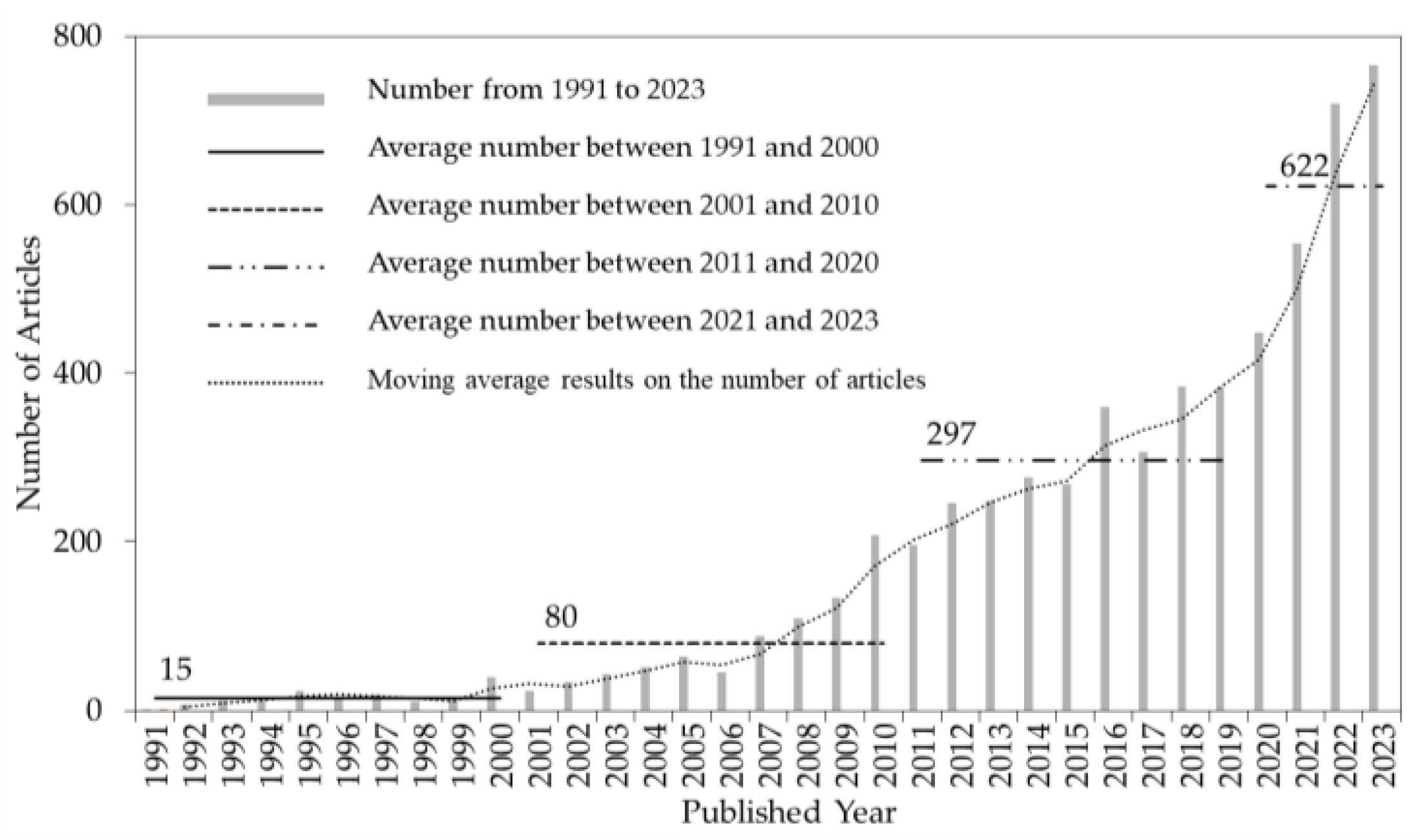
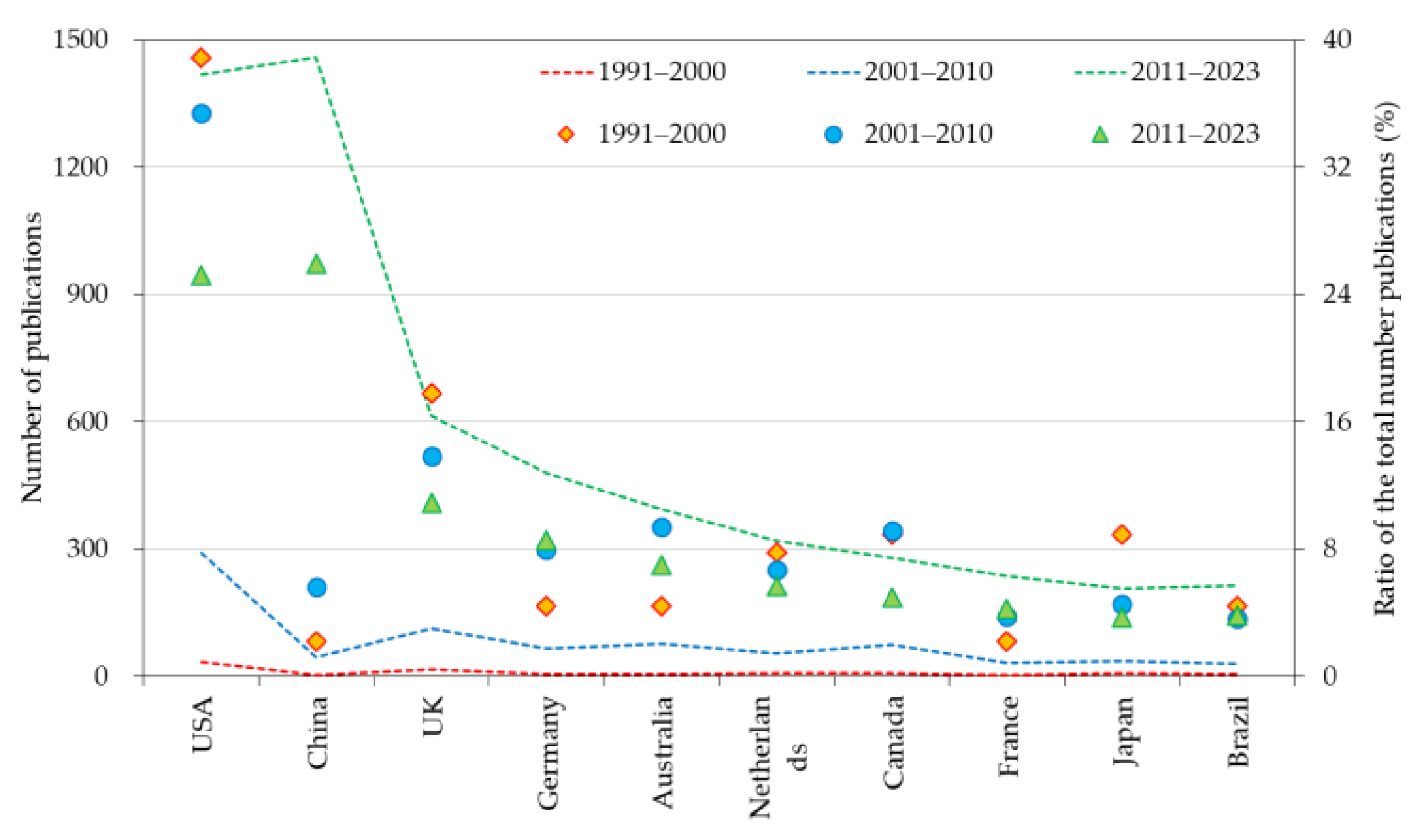

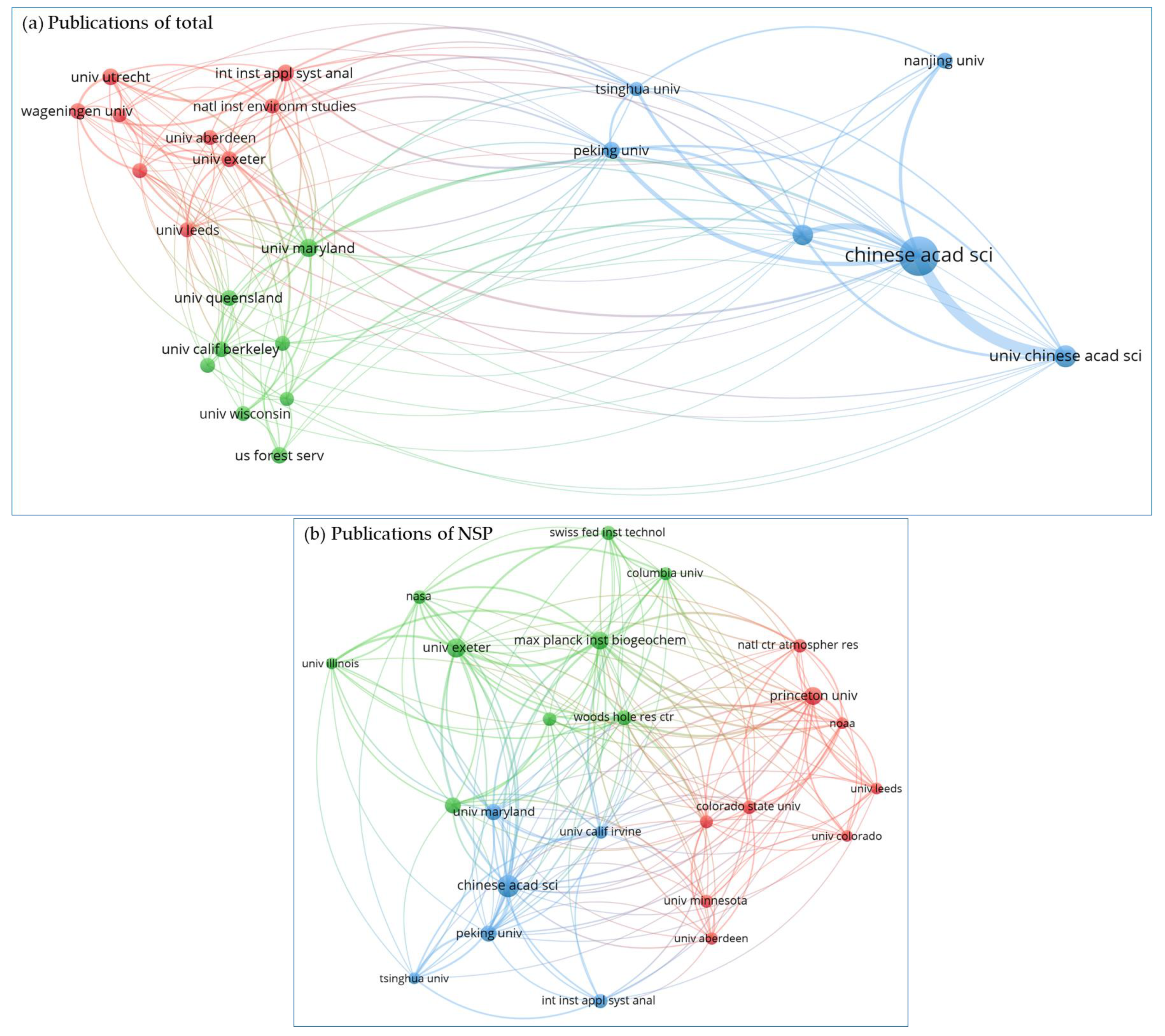
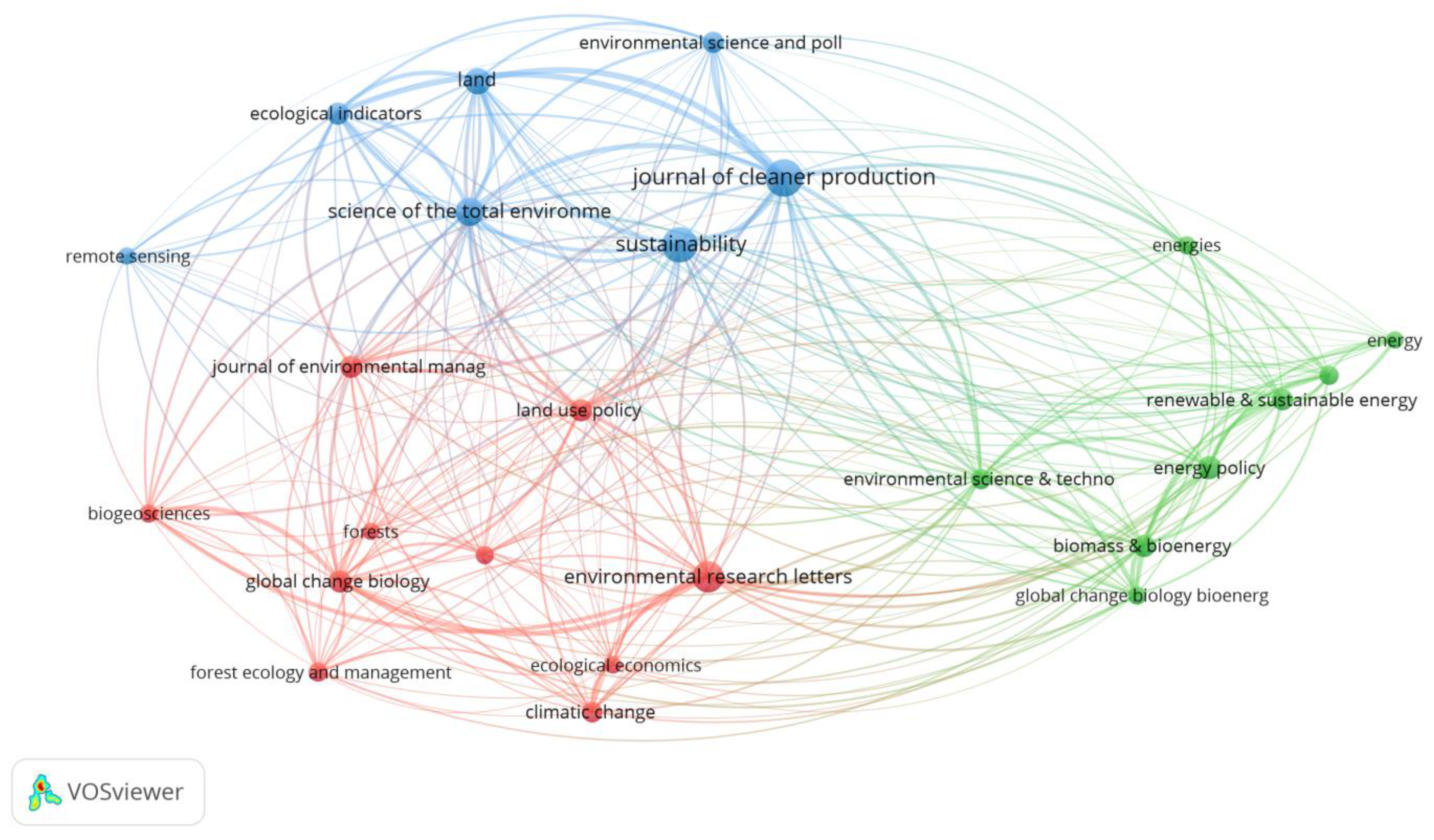
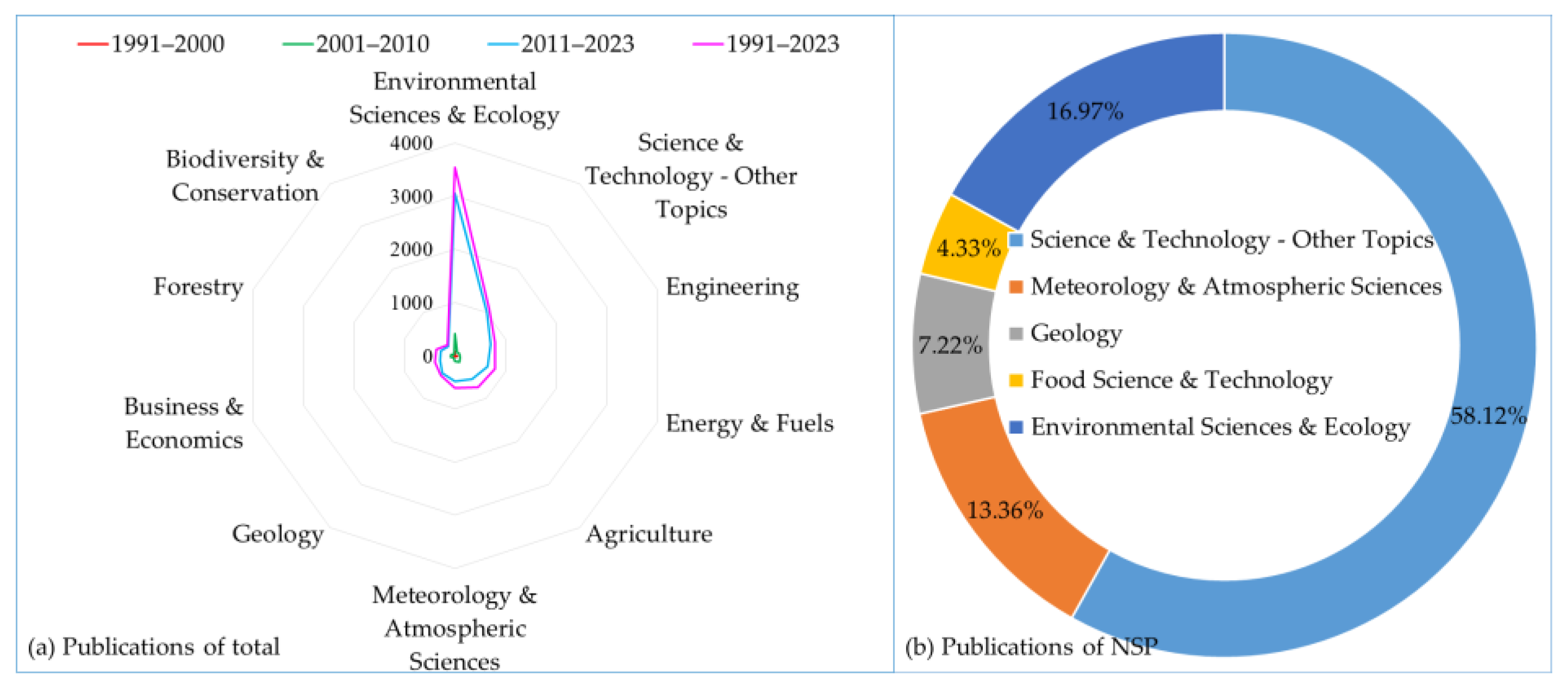



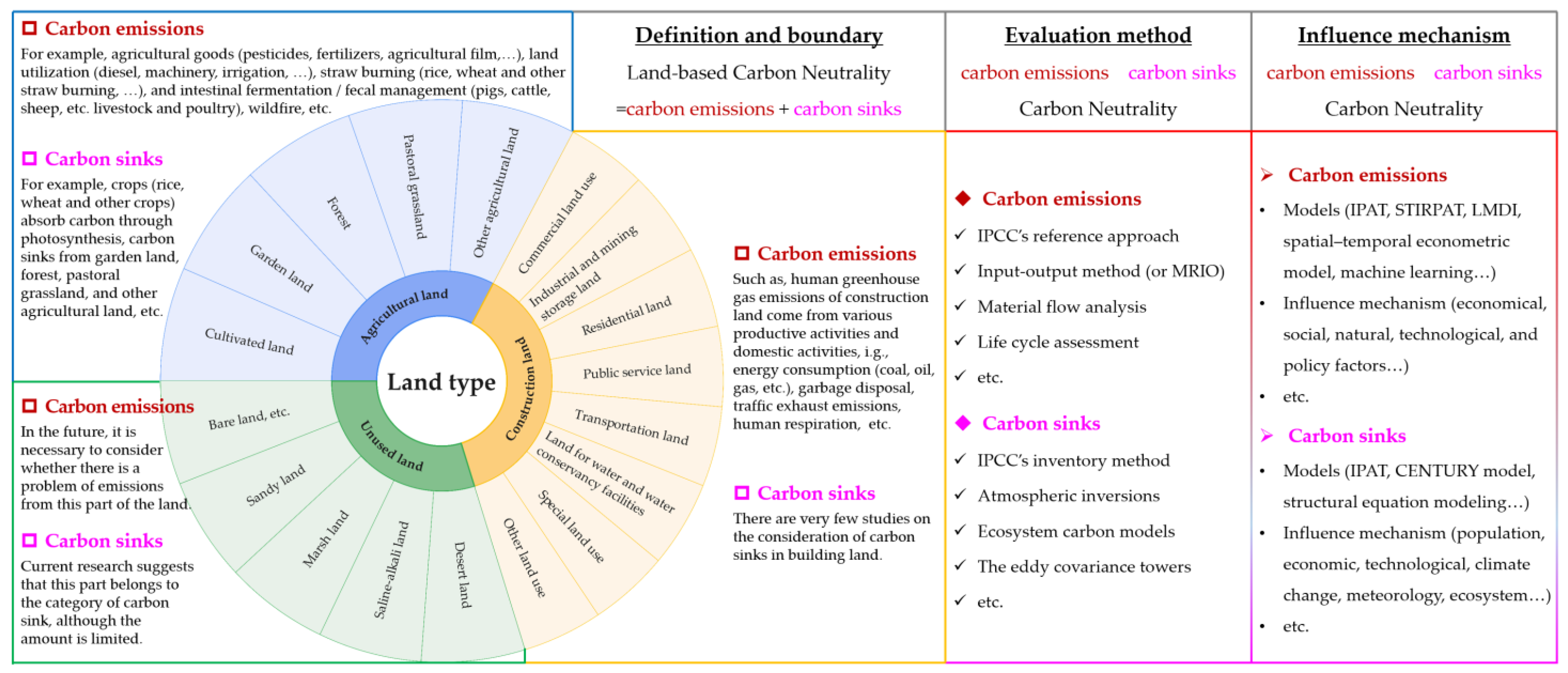
| Rank | Institutions | Country | Number | Ratio (%) |
|---|---|---|---|---|
| 1 | Chinese Academy of Sciences | China | 386 | 2.19 |
| 2 | Wageningen University | Netherlands | 112 | 0.64 |
| 3 | Beijing Normal University | China | 101 | 0.57 |
| 4 | International Institute for Applied Systems Analysis | Austria | 92 | 0.52 |
| 5 | University of Maryland | USA | 92 | 0.52 |
| 6 | National Institute for Environmental Studies | Japan | 76 | 0.43 |
| 7 | University of Exeter | UK | 73 | 0.41 |
| 8 | Utrecht University | Netherlands | 73 | 0.41 |
| 9 | United States Forest Service | USA | 70 | 0.40 |
| 10 | Peking University | China | 67 | 0.38 |
| Rank | Journals | Number | Ratio (%) | 2022 IF | JCR | Country |
|---|---|---|---|---|---|---|
| 1 | Journal of Cleaner Production | 249 | 4.07 | 11.1 | Q1 | USA |
| 2 | Sustainability | 226 | 3.70 | 3.9 | Q2 | Switzerland |
| 3 | Environmental Research Letters | 174 | 2.84 | 6.7 | Q1 | UK |
| 4 | Science of the Total Environment | 144 | 2.35 | 9.8 | Q1 | Netherlands |
| 5 | Land | 127 | 2.08 | 3.9 | Q2 | Switzerland |
| 6 | Energy Policy | 96 | 1.57 | 9.0 | Q1 | UK |
| 7 | Global Change Biology | 93 | 1.52 | 11.6 | Q1 | UK |
| 8 | Journal of Environmental Management | 90 | 1.47 | 8.7 | Q1 | UK |
| 9 | Biomass & Bioenergy | 89 | 1.46 | 6.0 | Q2 | UK |
| 10 | Land Use Policy | 89 | 1.46 | 7.1 | Q1 | UK |
| No. | Title | First Author | Journal Source | Year | Times |
|---|---|---|---|---|---|
| 1 | Accelerated dryland expansion under climate change | Huang, Jianping | Nature Climate Change | 2016 | 1439 |
| 2 | The Shared Socioeconomic Pathways and their energy, land use, and greenhouse gas emissions implications: An overview | Riahi, Keywan | Global Environmental Change-Human and Policy Dimensions | 2017 | 1433 |
| 3 | Natural climate solutions | Griscom, Bronson W. | PNAS | 2017 | 1324 |
| 4 | Climate and carbon cycle changes from 1850 to 2100 in MPI-ESM simulations for the Coupled Model Intercomparison Project phase 5 | Giorgetta, Marco A. | Journal of Advances in Modeling Earth Systems | 2013 | 1119 |
| 5 | Global fire emissions estimates during 1997–2016 | van der Werf, Guido R. | Earth System Science Data | 2017 | 1029 |
| 6 | Reduced carbon emission estimates from fossil fuel combustion and cement production in China | Liu, Zhu | Nature | 2015 | 1022 |
| 7 | Global Carbon Budget 2016 | Le Quéré, Corinne | Earth System Science Data | 2016 | 943 |
| 8 | Contribution of semi-arid ecosystems to interannual variability of the global carbon cycle | Poulter, Benjamin | Nature | 2014 | 935 |
| 9 | Global Carbon Budget 2019 | Friedlingstein, Pierre | Earth System Science Data | 2019 | 922 |
| 10 | The dominant role of semi-arid ecosystems in the trend and variability of the land CO2 sink | Ahlstrom, Anders | Science | 2015 | 898 |
Disclaimer/Publisher’s Note: The statements, opinions and data contained in all publications are solely those of the individual author(s) and contributor(s) and not of MDPI and/or the editor(s). MDPI and/or the editor(s) disclaim responsibility for any injury to people or property resulting from any ideas, methods, instructions or products referred to in the content. |
© 2024 by the authors. Licensee MDPI, Basel, Switzerland. This article is an open access article distributed under the terms and conditions of the Creative Commons Attribution (CC BY) license (https://creativecommons.org/licenses/by/4.0/).
Share and Cite
Liu, L.; Qu, J.; Gao, F.; Maraseni, T.N.; Wang, S.; Aryal, S.; Zhang, Z.; Wu, R. Land Use Carbon Emissions or Sink: Research Characteristics, Hotspots and Future Perspectives. Land 2024, 13, 279. https://doi.org/10.3390/land13030279
Liu L, Qu J, Gao F, Maraseni TN, Wang S, Aryal S, Zhang Z, Wu R. Land Use Carbon Emissions or Sink: Research Characteristics, Hotspots and Future Perspectives. Land. 2024; 13(3):279. https://doi.org/10.3390/land13030279
Chicago/Turabian StyleLiu, Lina, Jiansheng Qu, Feng Gao, Tek Narayan Maraseni, Shaojian Wang, Suman Aryal, Zhenhua Zhang, and Rong Wu. 2024. "Land Use Carbon Emissions or Sink: Research Characteristics, Hotspots and Future Perspectives" Land 13, no. 3: 279. https://doi.org/10.3390/land13030279
APA StyleLiu, L., Qu, J., Gao, F., Maraseni, T. N., Wang, S., Aryal, S., Zhang, Z., & Wu, R. (2024). Land Use Carbon Emissions or Sink: Research Characteristics, Hotspots and Future Perspectives. Land, 13(3), 279. https://doi.org/10.3390/land13030279










